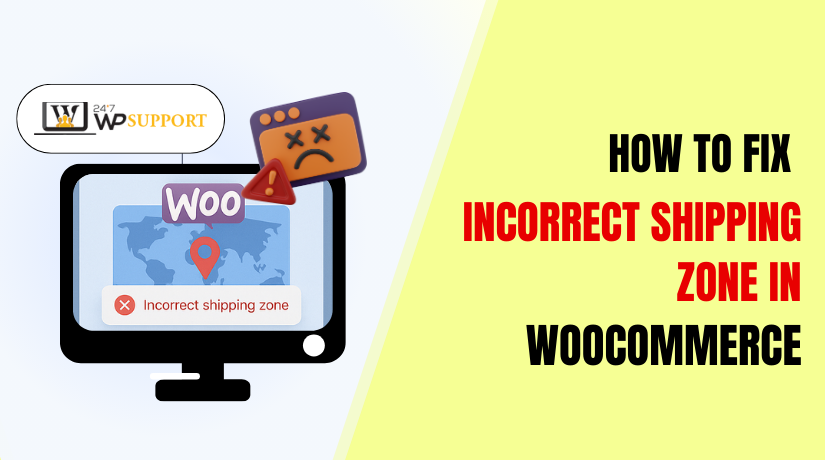
How to Fix Incorrect Shipping Zone in WooCommerce
Introduction
If you’re running a WooCommerce store, shipping is everything. A small error in shipping zones can cost you customers and sales. Many store owners face problems like the wrong shipping rate showing at checkout, or even worse — no shipping option at all. Although these problems are frequent, they can be resolved.
Let’s say a customer from California adds items to their cart. They head to checkout but see a shipping method meant for New York. Or sometimes, shipping costs don’t show up at all. This is a clear sign that your WooCommerce shipping zones are not working correctly.
Here’s what usually happens:
- Shipping zones are set up incorrectly.
- Customer addresses are not matched to the correct zone.
- The wrong shipping method is assigned to a zone.
- Plugins or custom code override zone logic.
These problems often lead to:
- Cart abandonment.
- Customer complaints.
- Reduced trust in your store.
The good news? To fix this, you don’t have to be a developer. With a clear process and a little guidance, you can solve this yourself. This guide will walk you through each possible cause, show you how to fix them, and help you avoid future errors.
Whether your shipping rules are not applying or your zone is not matching customer addresses, we’ve got you covered. Stick with us, and by the end, your WooCommerce shipping will be running smoothly again.
How WooCommerce Shipping Zones Work
Before fixing shipping zone issues, it’s important to understand how WooCommerce handles them. Shipping zones in WooCommerce define where and how you ship products. Each zone is linked to specific locations like countries, states, or ZIP codes.
For instance, you could create a zone for the US and then include shipping options like local pickup, free delivery, or flat fee for that area.
When a client provides their address, WooCommerce verifies:
- What country or state they are in.
- What ZIP code they’ve provided.
- Which zone their location matches.
Then, it shows only the shipping methods available for that matched zone.
WooCommerce matches zones as follows:
- Zones are checked according to their indicated sequence.
- The first matching zone is applied to the customer.
- If a customer’s address doesn’t match any defined zone, WooCommerce applies the default rule for “locations not covered by other zones.
This means zone order matters a lot. If multiple zones contain the same location, WooCommerce will match the first one in the list. If you’re seeing WooCommerce not detecting the correct shipping zone, this could be the reason.
Common mistakes in setup include:
- Overlapping zones (e.g., two zones covering all of the USA).
- ZIP code formatting issues (missing dashes or spaces).
- Not saving changes after editing a zone.
For USA-based stores, make sure to:
- Use correct state abbreviations (e.g., CA for California).
- Use 5-digit ZIP codes or ZIP code ranges correctly.
- Avoid duplicate entries in different zones.
Also, each zone must have at least one shipping method. Otherwise, no shipping will be shown.
If your WooCommerce shipping zone setup problem includes the wrong methods or no rates at checkout, double-check these basics. Most zone issues come from small setup errors that are easy to overlook.
Common Shipping Zone Issues in WooCommerce
Shipping zone issues in WooCommerce can be frustrating. You set everything up but still see wrong shipping at checkout or no shipping rates at all. We will examine the reasons of these issues in this section. Fixes will come later — here we focus only on identifying the root causes.
- Incorrect Zone Order
WooCommerce checks zones from top to bottom. It applies the first matching zone it finds. If your zones overlap, the wrong one might apply.
Example: You have one zone for the USA and another for California. If the USA zone is listed first, customers in California may match the USA zone instead.
- Overlapping Zones
Many store owners create multiple zones covering similar areas. For example:
- Zone 1: United States
- Zone 2: California, New York, Texas
If the system finds a match in more than one zone, it picks the first one. This often results in WooCommerce not detecting the correct shipping zone.
- Missing or Incorrect ZIP Codes
ZIP codes must be exact. If a customer’s ZIP doesn’t match the format, they won’t be placed in the right zone.
Common mistakes include:
- Not using ZIP code ranges
- Leaving ZIP code fields blank
- Using wrong formats like “90210-1234” instead of “90210”
This causes the shipping zone to not match customer locations.
- No Shipping Method Assigned
At least one method must be added for each shipping zone. WooCommerce won’t provide any shipping options if there isn’t a method.
This often leads to:
- “No shipping available” errors
- Shipping not calculating correctly in WooCommerce
- Plugin Conflicts or Custom Code
Sometimes, a theme or plugin may override shipping settings. Custom checkout plugins or shipping calculators may conflict with zone logic.
This can result in:
- Wrong shipping showing at checkout in WooCommerce
- Missing shipping methods
- Customer Address Not Complete
If a user enters only partial address details, WooCommerce may not match them to a zone. A missing state or incorrect ZIP code can break the logic.
You might see:
- Incomplete shipping cost calculations
- No rates shown at all
- Cached or Outdated Data
Caching plugins may store outdated shipping settings. Even after fixing zones, changes may not show unless cache is cleared.
This can cause:
- Shipping rules not applying properly
- Inconsistent shipping rates
How to Fix Incorrect Shipping Zones in WooCommerce (Step-by-Step Guide)
You’re not alone if your WooCommerce store displays inaccurate shipping costs or none at all. The good news is that most problems are simple to resolve, even though this occurs frequently.
In this section, we’ll show you how to solve your shipping zone issues in a practical way. These solutions cover both basic and advanced scenarios.
Step 1: Check the Order of Your Shipping Zones
Shipping zones are applied by WooCommerce in the order that they are listed.
If multiple zones include the same area, the first match wins.
Here’s what to do:
- Go to WooCommerce > Settings > Shipping > Shipping Zones
- Check the list of zones
- Make sure specific zones (like a state) are listed above general zones (like the whole country)
For example:
- Put “California” above “United States”
- This ensures WooCommerce picks the correct zone first
If this step is omitted, the incorrect postage may appear at checkout.
Step 2: Double-Check Customer Address Formatting
WooCommerce matches a customer’s address to your zones. If their address is incomplete or mismatched, the system fails to apply correct shipping.
Check that:
- Customers are entering the correct state and ZIP code
- Your shipping zones match those same state codes (e.g., “CA” for California)
Sometimes, shipping fails because:
- ZIP code is missing or mistyped
- State is not selected properly in checkout
- Store setup is missing U.S. region abbreviations
This leads to shipping not calculating correctly in WooCommerce.
Step 3: Make Sure Each Zone Has a Shipping Method
No shipping method = no shipping rate shown.
WooCommerce requires you to add at least one method per zone.
Steps:
- Go to the Shipping Zone you want to check
- Click “Edit” next to the zone name
- Click “Add shipping method” and choose one:
- Flat rate
- Free shipping
- Local pickup
Also make sure:
- Shipping method is enabled
- Settings like tax or fee are configured properly
If a zone has no method assigned, users may see:
- “No shipping options available”
- Checkout errors
Step 4: Review Your ZIP Code and Location Settings
ZIP codes are often the root of many zone problems. WooCommerce lets you:
- Enter individual ZIP codes (e.g., 90210)
- Use ZIP code ranges (e.g., 90000…90999)
Common mistakes include:
- Forgetting to include ZIP codes
- Using incorrect formatting
- Entering spaces or extra characters
Fix it by:
- Editing your zone and scrolling to the “Region(s)” section
- Add correct ZIP codes for U.S. regions
- Use ranges if your shipping method applies broadly
This can prevent the WooCommerce shipping zone not matching customer problem.
Step 5: Clear Caches and Saved Data
WP Super Cache and W3 Total Cache are two examples of caching plugins that may save previous shipment configurations.
Always clear cache after making changes:
- Clear your site cache
- Clear your browser cache
- Clear WooCommerce transients:
- Go to WooCommerce > Status > Tools
- Click “Clear transients” and “Clear shipping rates cache”
Failing to clear cache may result in:
- Old rates still showing
- Shipping rules not applying properly
Step 6: Use Shipping Debug Mode
WooCommerce has a built-in shipping debug tool.
Here’s how to use it:
- Go to WooCommerce > Settings > Shipping
- Click the “Shipping Options” tab
- Enable Debug Mode
Then:
- Visit your site as a customer
- Add a product to the cart
- Go to checkout
You’ll see detailed info about:
- Which zone was matched
- Which methods are being applied
- Any missing or conflicting details
This helps pinpoint if WooCommerce shipping zone override is not working.
Step 7: Check for Plugin or Theme Conflicts
Custom themes or third-party shipping plugins may override default WooCommerce logic.
Look out for:
- Checkout field editors
- Shipping calculator plugins
- Multi-vendor marketplace tools
Steps to troubleshoot:
- Deactivate all plugins except WooCommerce
- Change to the default theme (Storefront, for example).
- Test shipping at checkout
If the issue disappears, then a plugin was the cause. To identify the conflict, re-enable each one individually.
You can also:
- Examine the functions.php file in your theme.
- Look for any code that modifies shipping behavior
These conflicts are common causes of fix shipping method mismatch in WooCommerce.
Step 8: Avoid Overlapping Zones
Only one zone applies to a customer. Avoid creating two zones that cover the same area.
For example:
- One zone for “United States”
- Another zone for “California, New York, Florida”
If these overlap and are both active, only the first listed one will apply.
Overlapping zones often lead to WooCommerce shipping zones not working correctly.
Advanced Troubleshooting Tips for WooCommerce Shipping Zones
Sometimes, even after applying the standard fixes, the shipping zone problem still exists. This usually means something deeper is interfering with WooCommerce’s logic. We’ll go over some advanced troubleshooting techniques in this section to assist you in locating and resolving hidden problems.
- Use a Staging Site for Safe Testing
A staging site is a duplicate version of your live website used for safe testing. It lets you test changes without affecting real customers.
You can:
- Test shipping changes without going live
- Try disabling plugins safely
- Switch themes without breaking your store
Many hosting providers offer one-click staging. You can also use plugins like:
- WP Staging
- Duplicator
Using a staging site prevents errors during live troubleshooting.
- Check for Plugin Conflicts
Some plugins may override or block WooCommerce shipping rules. These include:
- Multi-vendor plugins
- Shipping calculators
- Custom checkout or shipping method plugins
To test for conflicts:
- Disable all plugins except WooCommerce
- Switch to a default theme like Storefront
- Try checking out with a test product
If shipping works correctly now, one of your plugins is the issue. To identify the conflict, reactivate each plugin individually.
- Use Debug Tools and Logs
WooCommerce provides logs that help you trace issues.
Go to:
- WooCommerce > Status > Logs
- Select the latest log from the dropdown
- Review shipping-related errors or warnings
You can also enable Shipping Debug Mode:
- Go to WooCommerce > Settings > Shipping > Shipping Options
- Enable Debug Mode
You’ll see exactly:
- Which zone matched
- What method was applied
- Why a rate was rejected
This is useful when WooCommerce is not detecting the correct shipping zone.
- Clear Site and Browser Cache Again
Sometimes, changes won’t show because your site is cached.
Make sure to:
- Clear WordPress cache
- Clear browser cache
- Clear WooCommerce transients (under WooCommerce > Status > Tools)
This resolves cases where changes don’t reflect at checkout.
Best Practices to Avoid Shipping Zone Issues in WooCommerce
Fixing shipping zone problems is important, but preventing them is even better. Following a few best practices can help you avoid issues like wrong shipping showing at checkout or shipping rules not applying. Let’s go through simple ways to keep your shipping setup smooth and error-free.
- Keep Your Shipping Zones Organized
Organize your zones clearly. Always place specific regions before general ones.
For example:
- Place “California” above “United States”
- Keep local zones grouped together
Avoid overlapping locations between different zones. This helps WooCommerce apply the correct zone every time.
- Test Your Checkout Regularly
Every time you update WooCommerce or a shipping plugin, test your checkout.
Use real U.S. addresses from different:
- States
- ZIP code ranges
- Customer types (guest and logged-in)
This enables you to identify problems before your clients do.
- Update WooCommerce and Plugins
Always keep WooCommerce, themes, and plugins up to date. Shipping logic may change after an update. Delaying updates increases the risk of:
- Plugin conflicts
- Outdated shipping methods
- Broken rules
Before deploying updates to the live store, test them on a staging site.
- Document Your Shipping Setup
Keep a simple list of:
- All your shipping zones
- Methods assigned to each zone
- ZIP codes or state rules added
Future adjustments will be simpler and quicker as a result. You can refer to it when expanding or editing your store.
- Avoid Unnecessary Plugins
Don’t install plugins that change shipping behavior unless you really need them. Extra plugins may cause:
- Conflicts with WooCommerce logic
- Errors in zone detection
Stick to well-known and updated plugins only.
Conclusion
Shipping zone issues can silently damage customer trust and your store’s reputation. Ensuring accurate shipping rates at checkout isn’t just good practice — it’s essential for smooth sales. If your WooCommerce store is still showing the wrong shipping methods or missing zones, it’s time to take action.
Need expert help? 24x7wpsupport.com is here to assist you. Our WooCommerce specialists can troubleshoot, fix, and optimize your shipping settings fast — so you never lose a sale again.
Don’t let shipping problems hurt your business. Contact us now for instant support and reliable solutions — available 24×7.
Looking for more WordPress help? Subscribe to our YouTube Channel for expert video tutorials. Join us on Twitter and Facebook for updates, tips, and insights.



